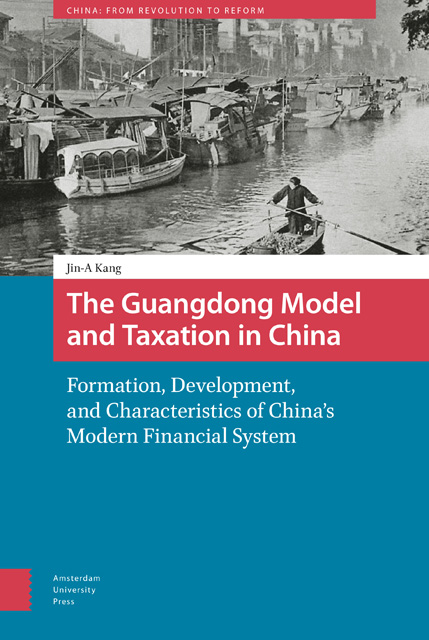 The Guangdong Model and Taxation in China
The Guangdong Model and Taxation in China Book contents
- Frontmatter
- Table of Contents
- Abbreviations
- Acknowledgments
- Introduction: The Modern Transformation of the Imperial Fiscal System: The Case of Provincial Finance in Guangdong
- Part 1 New Tax Revenues in Guangdong during the Republican Era
- Part 2 State-led Industrialization and the State Monopoly
- Part 3 Reform of Tax Collection
- Part 4 The Transition of the Modern Chinese Tax Structure in a Global Context
- Bibliography
- Glossary
- Index
3 - Abolition of the Likin and the Paradox of Tax Reform: The Special Tax
Published online by Cambridge University Press: 10 January 2023
- Frontmatter
- Table of Contents
- Abbreviations
- Acknowledgments
- Introduction: The Modern Transformation of the Imperial Fiscal System: The Case of Provincial Finance in Guangdong
- Part 1 New Tax Revenues in Guangdong during the Republican Era
- Part 2 State-led Industrialization and the State Monopoly
- Part 3 Reform of Tax Collection
- Part 4 The Transition of the Modern Chinese Tax Structure in a Global Context
- Bibliography
- Glossary
- Index
Summary
Abstract
From the late Qing to the 1920s, abolition of the likin was always a priority on the Chinese tax reform agenda. The newly established Nationalist Government in Nanjing finally announced the policy of “abolishing the likin and creating a new tax” in conjunction with restoring tariff sovereignty. This chapter examines how the Guangdong provincial government responded to the central government's policy by focusing on creating the Special Tax. The Chen Jitang separatist regime in Guangzhou responded to preemptively abolishing the likin and miscellaneous taxes and reinventing the special tax as a kind of local tariff instead. The special tax became the largest source of financial revenue in Guangdong province through the 1930s.
Keywords: Special Tax, Guangdong, local tariff, China
From the late Qing to the 1920s, abolition of the likin was always a priority on the Chinese tax reform agenda. But it was not until the establishment of the Nanjing Nationalist Government (hereafter NNG) that the policy of “abolishing the likin and creating a new tax” (caili jiashui) was implemented in conjunction with the restoration of tariff sovereignty. The NNG secured high-revenue income by raising the tariff rate instead of promising abolition of the likin from the Western powers. To compensate for the loss of expected revenue loss due to the abolition of the likin, the NNG allocated land taxes to the local governments. However, Guangdong province, which was already highly commercialized, could not match the loss of the likin with gains from the land tax. This chapter examines how the Guangdong provincial government (hereafter, the GPG) responded to the central government's policy to abolish the likin in the 1930s by focusing on the creation of the “special tax.”
The origins of the special tax: Between the likin and tariffs
The special tax was a local tariff on foreign goods transferred to Guangdong province. However, in reality it was more complicated. First, it had the nature of a tariff in that it targeted imported goods. Second, it had the nature of the likin in that domestic cargo from other provinces could also be subject to this taxation.
- Type
- Chapter
- Information
- The Guangdong Model and Taxation in ChinaFormation, Development, and Characteristics of China's Modern Financial System, pp. 67 - 106Publisher: Amsterdam University PressPrint publication year: 2022
